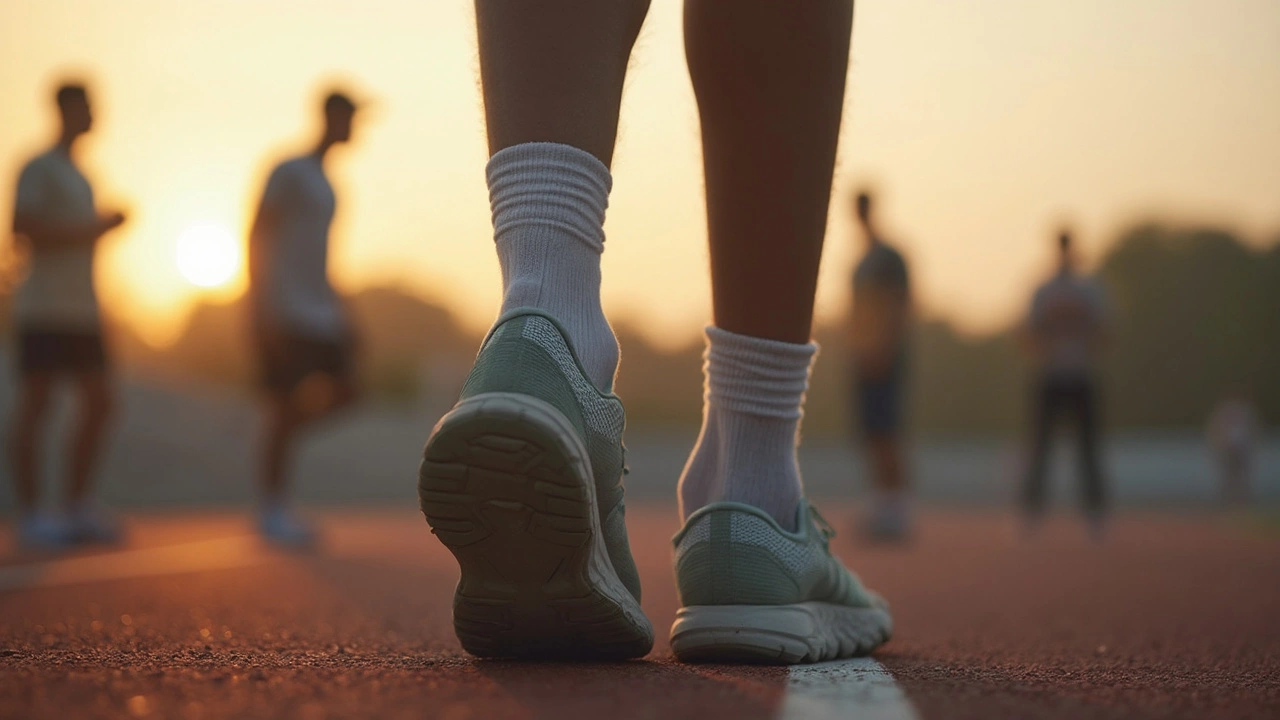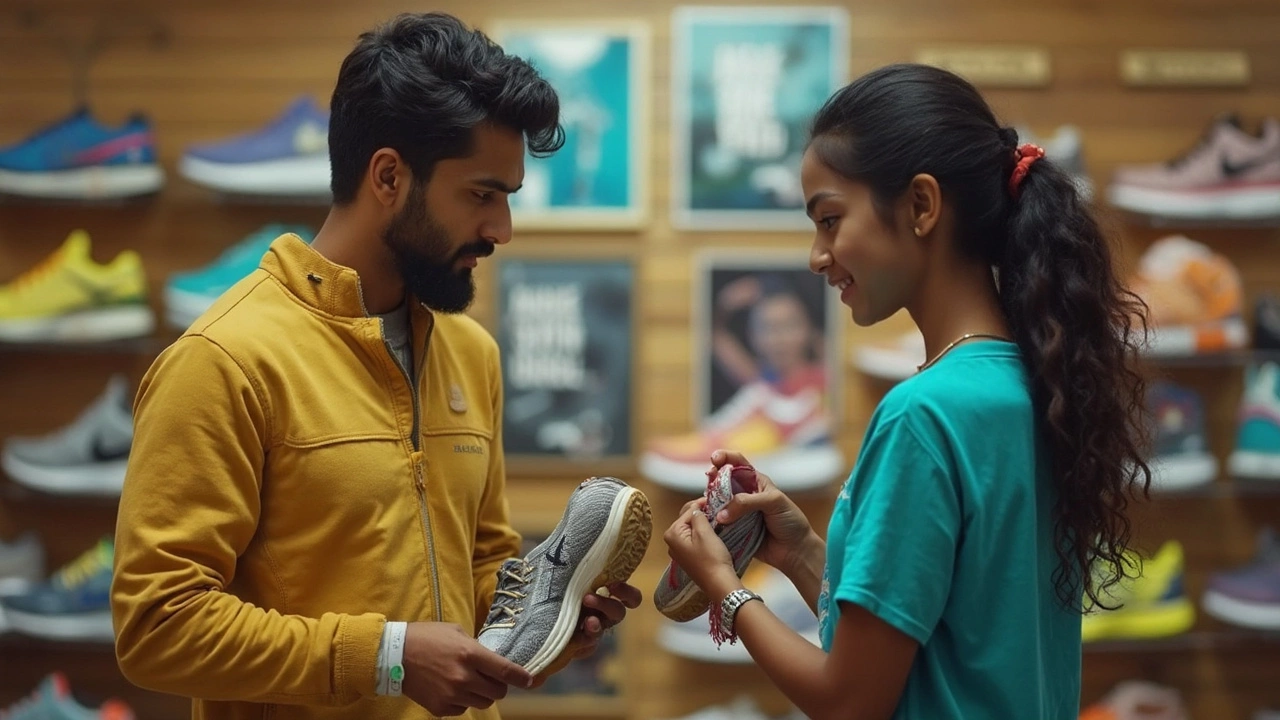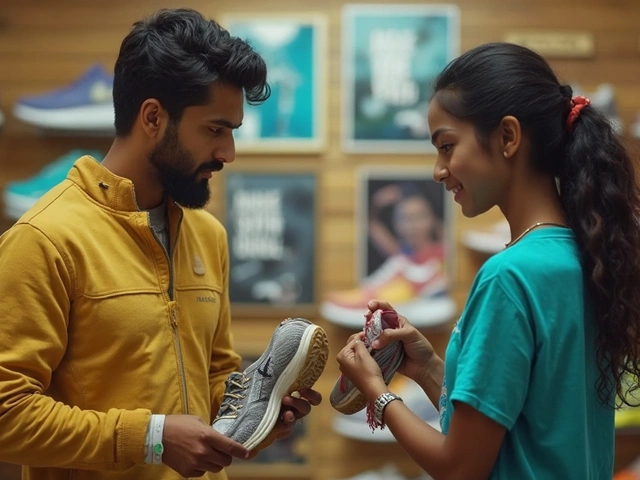You’d be surprised how many runners walk out of a store with shoes that are either too tight or way too loose. So, should you go for that extra half size or stick with what fits right now? The truth is, running isn’t like lounging around the house. Your feet expand with every mile, especially on long or hot runs. Stick your feet in snug shoes, and you might end up with blisters, black toenails, or worse—injuries that keep you benched.
But don’t just assume bigger is always better. A shoe that’s too roomy means slipping, sliding, and a lack of control. You want enough wiggle room for your toes, but not so much that your heel floats with every step. If you often get sore toenails or find your feet are throbbing when you peel off your shoes post-run, your sizing might be off. Let’s break down what actually happens to your feet when you run, and why so many coaches and pro runners have hard opinions about those spare centimeters at the front of your shoe.
- Why Shoe Size Matters More Than You Think
- What Happens to Your Feet When You Run
- When Going Bigger Makes Sense
- Common Sizing Mistakes Runners Make
- Tips for Finding Your Perfect Fit
- What the Pros and Studies Say
Why Shoe Size Matters More Than You Think
This isn’t just about comfort—getting the right running shoes size prevents injuries, boosts performance, and saves money. Around 72% of runners buy shoes that don't fit properly, based on a major study out of Austria. That number sounds wild, but take a look at most runners’ blackened toenails and taped-up blisters—clearly, there’s a problem.
Your feet aren’t static. They swell, flex, and spread out with each step. The wrong size messes with all that. Shoes that are too small cram your toes, leading to nail damage, numbness, bunions, or even stress fractures. Shoes that are too big make your feet slide forward, causing blisters on your toes and heels. This can throw off your stride, making your legs and back work harder just to keep your balance. That adds up to pain and slower times.
It’s not just your toes at risk. Sizing mistakes with running shoes can make you prone to sprained ankles, shin splints, and plantar fasciitis. Even a half-size error can mean the difference between a great run and limping home. Here’s a quick look at why this happens:
- Feet often swell up to half a size when running, especially in hot or long races.
- Running socks can add bulk, changing how your shoes fit.
- Poorly fitting shoes force you to adjust your form, raising injury risk.
Got an average shoe size in mind? Here’s what research found for active adults:
| Gender | Common Shoe Size (US) | Change During Run |
|---|---|---|
| Men | 9-11 | +0.5 size during activity |
| Women | 7-9 | +0.5 size during activity |
The upshot? You can't just look at your street shoe size and figure you’re set for the perfect running shoe fit. If you want to avoid common runner injuries and enjoy the miles, it’s time to pay way more attention to your shoe size than you probably ever have before.
What Happens to Your Feet When You Run
The moment you hit the pavement, your feet start to change—literally. On every stride, your foot absorbs about three times your body weight, and all that pounding makes your feet swell up. It isn’t just a myth. On long runs or in hot weather, it’s pretty normal for your foot to get up to a half size bigger by the time you’re done.
Here’s what’s happening step by step:
- Blood Flow Increases: Your body pumps extra blood to your working muscles, including those in your feet. This helps cool you down but adds to swelling.
- Micro-Movement: As your foot strikes and pushes off, it spreads out a little more with every step. It’s like your foot flattens and widens temporarily.
- Socks and Sweat: Socks can get damp from sweat, which makes the skin swell up a bit, leading to more friction and rubbing inside your running shoes.
- Repetitive Motion: If your shoe is tight, there’s constant pressure on your toes, leading to black toenails or blisters, especially on downhills.
Ever noticed how your toes feel squished by the end of a marathon (or even after a 5K in hot weather)? You’re not alone. A study by the American Academy of Orthopaedic Surgeons found that most runners’ feet increase by at least a half size during longer runs. This is a big reason why many runners—pros included—size up when picking running shoes.
| Distance | Average Foot Swelling |
|---|---|
| 5K | Up to 2% |
| Half Marathon | 2-4% |
| Marathon | 4-6% |
The bottom line: your feet get bigger when you run. Shoe sizing that feels perfect when you first try them on can start to feel more like a vice after a tough workout, which is why paying attention to your actual foot shape and how much your feet swell is key for comfort and injury prevention. Make sure your shoe sizing takes all that into account, not just your regular day-to-day shoe size.
When Going Bigger Makes Sense
This is where things get real for runners. Plenty of people find that their regular shoe size just doesn’t cut it when it comes to running shoes. Here’s why: when you run, your feet swell. In fact, they can easily grow up to a half size during a longer run, especially on hot days. If your shoes are too tight to start, your feet have nowhere to go—which means trouble.
Sports medicine docs and seasoned coaches always hammer this point—going a half size or even a full size up can make a huge difference in comfort and injury prevention. According to the American Academy of Pediatrics, "Shoes that are too tight can cause blisters, calluses, and black toenails—going up half a size often solves the issue for distance runners."
Dr. Christina Rowland, physical therapist and running specialist, says, "When in doubt, err on the side of a bit more room at the front. Swelling is normal, but repeated toe trauma from shoes that are too tight is not."
Here’s when it really makes sense to size up your running shoes:
- You do long runs or marathons—your feet will swell more over longer distances.
- You wear thick socks or orthotics—these take up extra space inside your shoe.
- You have wide feet or a high arch—extra room means less chance of pinching or rubbing.
- You’ve had black toenails or foot pain from your shoes in the past—a clear sign it’s time to try a bigger size.
Race-day shoes are notorious for causing blisters if they’re an exact fit fresh out of the box. If you consistently end your runs with red or bruised toes, don’t be afraid to try on a size up, especially in your primary running shoes.
Check out this data from a Runner’s World survey of 1,000 runners:
| Runner Type | Preferred Sizing | Reported Toe Issues |
|---|---|---|
| Short Distance | True to size | 10% |
| Long Distance | Half size up | 33% |
| Marathon | Half to full size up | 56% |
The numbers show a clear pattern—the longer the distance, the more runners go up in size to beat the dreaded black toenail and mid-run misery. So, if you’re eyeing a new pair, don’t be afraid to step up in size.

Common Sizing Mistakes Runners Make
So many people mess up buying running shoes just because of a few classic mistakes. You’d be surprised how common it is. The biggest screw-up? Picking shoes that fit like your regular casual kicks. Running shoes have to deal with swelling, movement, and impact. That extra space gets important fast.
Another problem: shopping for shoes in the morning. Your feet are actually a bit smaller then. By the end of the day, or after a few miles, your feet swell. Shoe experts and marathon coaches agree—always shop late in the day or after a light jog.
Lots of people forget to try shoes on with the socks they actually run in. If you wear thick cushioned socks but test fit with thin dress socks, you’re asking for trouble. The fit will be totally off during real runs.
Sometimes, folks buy their shoe size from the label instead of checking real-world fit. Forget numbers for a second: your toes shouldn’t squish against the front. Aim for a thumb’s width, usually about half an inch, between your longest toe and the front of the shoe. More or less, and you’re in the danger zone for black toenails or heel blisters.
| Common Mistake | What Can Happen |
|---|---|
| Tight fit | Blisters, black toenails, numbness |
| Shoes too loose | Slipping, bruised toes, less control |
| Wrong socks for fitting | Poor fit, unexpected rubbing or pressure |
| Shopping at the wrong time | Shoes feel too tight during runs |
Another one? Not re-measuring your feet every year or so. Feet change, especially if you gain or lose weight, or after pregnancy. If you’re set on a brand, be careful—each one has a different idea of sizes. Always check the brand’s size chart and, if possible, measure both feet. They’re not always twins.
And, last thing—don’t get locked in on style or a trendy brand. Those neon green shoes might look cool but if they destroy your toes, they’re worthless. Focus on fit and comfort first. You’ll rack up more happy miles and avoid spending money fixing issues that a proper fit would’ve prevented.
Tips for Finding Your Perfect Fit
Nailing the right running shoes size can save your feet and your wallet. Don’t just trust what’s printed on the box—brands have their quirks. Here’s how to zero in on the best fit for you.
- Measure Your Feet Late in the Day: Your feet swell as the day goes on, just like they do during a run. Grab a ruler or Brannock device and measure your feet in the evening, standing up for reliable numbers.
- Wear Your Running Socks When Fitting: Those thick athletic socks take up space. Always try on running shoes with the socks you plan to actually run in.
- Leave a Thumb's Width: Experts usually say you want about a thumb’s width (roughly half an inch) between your longest toe and the front of the shoe. This leaves room for swelling and keeps your toenails safe on downhills.
- Check Heel Fit: Your heel shouldn’t slip, even a little. If you feel your heel moving, you’re asking for blisters.
- Test Run in the Store: Most specialty shops will let you jog around inside or on a treadmill. If you feel any pinching or rubbing right away, it’s a dealbreaker.
- Know That Sizing Isn't Universal: A size 10 in Nike won’t always fit like a size 10 in Brooks or Asics. Always check the brand’s size chart. For runners who like hard facts, studies have shown that about 60% of people wear the wrong shoe size—often too small!
Here’s a quick look at typical sizing changes across popular brands, since runners often mix them up:
| Brand | Known Sizing |
|---|---|
| Nike | Runs narrow, usually true to size |
| Brooks | Roomier, a bit longer in toe box |
| Asics | Medium width, runs true |
| Hoka | Wider, may need to size down |
If you’re still unsure, most running stores have shoe experts who will check your gait and foot shape. Don’t be afraid to ask. Remember, the perfect running shoe fit should feel snug at the heel and midfoot, but let your toes move free. Pay attention to these simple tips and you’ll avoid the most common mistakes runners make each year.
What the Pros and Studies Say
If you’ve ever watched elite runners, you’ll notice they have strong opinions about running shoes and how they fit. Most coaches and experienced racers lean toward buying shoes a half to a full size bigger than their standard everyday sneakers. Why? They know from experience that feet swell as you rack up the miles, especially during longer runs and races.
In a 2017 study from the British Journal of Sports Medicine, marathon runners reported foot swelling that increased shoe size by almost half a size after several hours of running. That’s part of why the American Academy of Podiatric Sports Medicine actually recommends trying on new shoes in the evening or after a run, when your feet are at their biggest, instead of first thing in the morning.
Here’s what pro runners like Shalane Flanagan and Eliud Kipchoge do: they size up a bit for long-distance races to avoid black toenails and keep their feet comfortable when the kilometers add up. Kipchoge even mentions using shoes with a thumb’s width of space between his longest toe and the end of his shoe.
- Shoe size matters most during races and longer training runs, not just short jogs.
- Most specialty stores suggest leaving about a half-inch—or the width of your thumb—of space up front.
- Dr. Emily Splichal, a foot specialist, warns that shoes that are too tight are often the main cause of blisters and bruised toenails.
Check out this quick look at what different sources recommend for running shoe sizing:
| Expert/Source | Recommendation |
|---|---|
| American Academy of Podiatric Sports Medicine | Go up at least half a size from regular shoes |
| British Journal of Sports Medicine (2017) | Feet swell up nearly half a size during a marathon |
| Top Marathon Coaches | Leave a thumb-width space at the front of shoes |
Bottom line: just about every seasoned runner and sports doc will say the same thing—don’t be afraid to size up when you’re picking out your next pair of running shoes. It’s solid advice for injury prevention and overall comfort.


